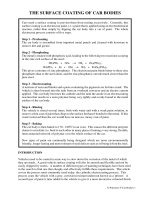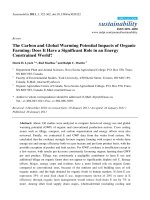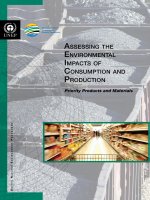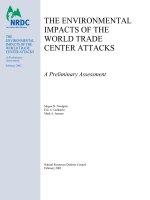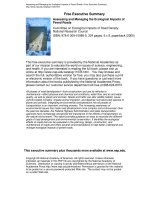Assessing and Managing the Ecological Impacts of Paved Roads pptx
Bạn đang xem bản rút gọn của tài liệu. Xem và tải ngay bản đầy đủ của tài liệu tại đây (688.62 KB, 44 trang )
Assessing and Managing the Ecological Impacts of Paved Roads (Free Executive Summary)
/>Free Executive Summary
ISBN: 978-0-309-10088-5, 324 pages, 6 x 9, paperback (2005)
This executive summary plus thousands more available at www.nap.edu.
Assessing and Managing the Ecological Impacts of
Paved Roads
Committee on Ecological Impacts of Road Density,
National Research Council
This free executive summary is provided by the National Academies as
part of our mission to educate the world on issues of science, engineering,
and health. If you are interested in reading the full book, please visit us
online at . You may browse and
search the full, authoritative version for free; you may also purchase a print
or electronic version of the book. If you have questions or just want more
information about the books published by the National Academies Press,
please contact our customer service department toll-free at 888-624-8373.
All phases of road development—from construction and use by vehicles to
maintenance—affect physical and chemical soil conditions, water flow, and air and water
quality, as well as plants and animals. Roads and traffic can alter wildlife habitat, cause
vehicle-related mortality, impede animal migration, and disperse nonnative pest species of
plants and animals. Integrating environmental considerations into all phases of
transportation is an important, evolving process. The increasing awareness of
environmental issues has made road development more complex and controversial. Over
the past two decades, the Federal Highway Administration and state transportation
agencies have increasingly recognized the importance of the effects of transportation on
the natural environment. This report provides guidance on ways to reconcile the different
goals of road development and environmental conservation. It identifies the ecological
effects of roads that can be evaluated in the planning, design, construction, and
maintenance of roads and offers several recommendations to help better understand and
manage ecological impacts of paved roads.
Copyright © National Academy of Sciences. All rights reserved. Unless otherwise
indicated, all materials in this PDF file are copyrighted by the National Academy of
Sciences. Distribution or copying is strictly prohibited without permission of the National
Academies Press Permission is granted for this material
to be posted on a secure password-protected Web site. The content may not be posted
on a public Web site.
Copyright © National Academy of Sciences. All rights reserved.
This executive summary plus thousands more available at
Assessing and Managing the Ecological Impacts of Paved Roads
/>1
Summary
There are 4 million miles of roads in the United States. One hun-
dred years ago, roads were primarily unpaved and had half the number of
miles of the present U.S. road system. As the system grew, roads be-
came wider and more complex structurally to provide for more and heav-
ier traffic. New construction technology and greater structural stability
were needed to improve the road system.
All phases of road development—from construction and use by ve-
hicles to maintenance—affect physical and chemical soil conditions, wa-
ter flow, and air and water quality. Roads alter habitats, increase wildlife
mortality, and disperse nonnative pest species of plants and animals. At
larger scales, roads affect wildlife migration patterns. In some cases,
roads can also enhance roadside habitats for native species.
The importance of integrating environmental considerations into all
phases of transportation is emphasized in legislation. The Transportation
Equity Act for the Twenty-First Century (TEA-21) of 1998 called for
protection of the environment by initiating transportation projects that
would improve environmental quality and support fuel efficiency,
cleaner fuels, and alternative transportation. The act called for streamlin-
ing procedures to reduce red tape and paperwork in transportation project
reviews without compromising environmental protection.
Consideration of environmental issues in road development has
been an evolving process. The increasing awareness of environmental
issues, regulatory changes, and new solutions have made road develop-
ment more complex and controversial. Many believe that environmental
protection can be compatible with streamlining the project approval
process through effective planning and coordination. Suggestions on
Copyright © National Academy of Sciences. All rights reserved.
This executive summary plus thousands more available at
Assessing and Managing the Ecological Impacts of Paved Roads
/>2 Assessing and Managing the Impacts of Paved Roads
how environmental and transportation goals can be better integrated have
been developed by government agencies and nongovernmental organiza-
tions. Approaches include more integrated planning and interagency
coordination, consideration of alternative designs earlier in the planning
process, and consideration of mitigation strategies, such as installation of
wildlife crossings and native vegetation management. As the road sys-
tem expands and construction and management require additional re-
sources, more is understood about the impact of roads on the environ-
ment, but much remains to be learned. To address these matters, better
understanding of road ecology and improved methods of integrating that
understanding into all aspects of road development are needed.
Over the past two decades, the Federal Highway Administration
and state transportation agencies have increasingly recognized the impor-
tance of the effects of transportation facilities on the natural environ-
ment. The importance of this issue was reflected by congressional action
in Section 5107(b)(4) of TEA-21, which required the secretary of trans-
portation to “study the relationship between highway density and ecosys-
tem integrity, including the impacts of highway density on habitat integ-
rity and overall ecosystem health, and to develop a rapid assessment
methodology for use by transportation and regulatory agencies in deter-
mining the relationship between highway density and ecosystem integ-
rity.” Section 5107(d) of TEA-21 authorized the secretary to arrange for
a study of this relationship by the National Research Council (NRC). In
response, at the request of the Federal Highway Administration, the NRC
established the Committee on Ecological Impacts of Road Density (see
Statement of Task in Box S-1). This committee’s report attempts to pro-
vide guidance on ways to reconcile the different goals of road develop-
ment and environmental conservation.
The term “road density” is frequently used to mean the average to-
tal road length per unit area of landscape. However, roads also have
widely varying widths; therefore, lane miles per square mile (or lane
length per unit area) is a better measure of density because it takes into
account the differences between, for example, multilane expressways and
two-lane rural roads. The concept of road density was developed as a
way of quantifying one aspect of a road network and is applicable at
scales larger than a road segment. Road density may be appropriate for
measuring the structure of some existing road networks (especially those
few urban or rural systems in a rectilinear grid), but it is not the only
measurable term that can be used to describe road pattern and structure.
Copyright © National Academy of Sciences. All rights reserved.
This executive summary plus thousands more available at
Assessing and Managing the Ecological Impacts of Paved Roads
/>Summary 3
BOX S-1 Statement of Task
A multidisciplinary committee will be established to review the sci-
entific information on the ecological effects of road density, including
the impacts of roads and highway density on ecosystem structure
and functioning and on the provision of ecosystem goods and ser-
vices. The committee will focus on hard-surfaced roads and will as-
sess data and ecological indicators needed to measure those im-
pacts. Cumulative effects will be considered. The proposed study
will also provide a conceptual framework and approach for the de-
velopment of a rapid assessment methodology that transportation
and regulatory agencies can use to assess and measure ecological
impacts of road density. To the degree that the committee can iden-
tify documentation of their effectiveness, it will consider the potential
ameliorating effects of measures that might avoid, reduce, or com-
pensate for the effects of highways and highway density on the
structure and processes of ecosystems.
The committee will consider such questions as the following:
1. What are appropriate spatial scales for different ecological
processes that might be affected by roads?
2. The importance of various ecological models and their appro-
priateness to the analysis.
3. The applicability of various ecological indicators, such as those
recently recommended by the National Research Council.
4. The degree to which the national, regional, and local environ-
mental concerns expressed in such laws as the Endangered Species
Act and the Clean Water Act are relevant to the ecological effects of
roads.
The study will focus on all classes of hard-surfaced roads. The
committee will consider and describe as possible the various attrib-
utes of roads that have ecological significance, such as how the
right-of-way is managed, surface composition, and the presence or
absence of structures such as overpasses and underpasses. It will
consider the importance of the pattern of road layout on ecological
systems. It will not address global or regional climate effects, since
they are being studied under other initiatives. However, local climate
effects are appropriate in the scale of individual project design, con-
struction, and use, and are directly related to ecosystem perform-
ance in both long- and short-term contexts.
Copyright © National Academy of Sciences. All rights reserved.
This executive summary plus thousands more available at
Assessing and Managing the Ecological Impacts of Paved Roads
/>4 Assessing and Managing the Impacts of Paved Roads
There are cases in which the meaning of the term “road density” is
clear, but often it may be difficult to make useful comparisons between
the ecological effects of different types of road networks. For example,
several two-lane roads that have little traffic versus fewer, eight-lane
roads that are heavily traveled. Therefore, the committee focused on
variables that contribute to density, such as highway length and portion
of land covered, rather than strictly on density, and used the broader con-
cept of “scale” for evaluating environmental effects.
The committee focused on the ecological effects of federally
funded paved highways in urban and rural locations. The committee did
not focus on urban street networks, and no consideration was given to the
ecological effects of unpaved roads, such as those found in federal for-
ests, wilderness areas, wetlands, parks, and farms, or the ecological ef-
fects of state and local roads. The committee did not address global or
regional climate effects, such as how potential climate changes might
affect the interactions of organisms and the environment associated with
roads and vehicles or how roads and traffic might influence climate.
However, local climate interactions with road ecology are considered in
this report.
Developing policy choices to balance mobility, economic growth,
and environmental protection goals has been important and challenging
for more than 50 years. Although the committee was not charged to
evaluate such policy choices, it identified the ecological effects of roads
that can be evaluated in the planning, design, construction, and mainte-
nance of roads. The committee did not address human ecological fac-
tors; nonecological factors, such as safety; efficient movement of vehi-
cles; or protection of farmlands, publicly owned recreation lands, and
scenic, historic, and cultural areas. The committee also did not address
such factors as urban sprawl or suburban growth; project costs; state-
wide, regional, and local planning goals; and the economic viability of
the communities of users.
ECOLOGICAL EFFECTS OF ROADS
Perhaps the most noticeable ecological effect of roads is direct, ve-
hicle-related mortality (animals killed by collisions with vehicles). Al-
though it is not the most threatening effect of roads for most species,
mortality can reduce wildlife-population densities and ultimately affect
Copyright © National Academy of Sciences. All rights reserved.
This executive summary plus thousands more available at
Assessing and Managing the Ecological Impacts of Paved Roads
/>Summary 5
the survival probability of local populations, including endangered or
threatened species, such as the Florida panther and grizzly bear. In addi-
tion to vehicle-related mortality, roads―acting as barriers to wildlife
movement—may affect wildlife-population structure by disrupting
breeding patterns or impairing reproductive success because they can
fragment and isolate populations. In extreme cases, the resulting limita-
tion of gene flow could result in local extirpation of a species. Properly
designed mitigation measures, such as wildlife-crossing structures, can
facilitate wildlife movement across roads and reconnect isolated popula-
tions. Fish movement can also be blocked by road-crossing structures,
such as culverts (usually a large pipe under a road where it crosses a
stream) that are improperly designed or not present at all. Some fishes
avoid moving through culverts, possibly because of the increased speed
of the water flow, even if there are better habitat conditions on the oppo-
site side. Reluctance to move, for example, downstream, could contrib-
ute to isolating upstream populations and, in some cases, localized extir-
pations.
In evaluating the ecological effects of roads, it is important to con-
sider the physical, socioeconomic, and legal context, as well as the eco-
logical context. Each has spatial and temporal dimensions. The term
“road-effect zone” means the distance from a stretch of road or road seg-
ment that ecological effects can be detected. The road-effect zone is
usually asymmetric extending outward on either side of the road, with
varying zone boundaries. The effect of distance varies, depending on the
species, location, and disturbance type. For example, animals avoid
roads by a distance that increases with increasing traffic volume, and that
distance varies by species. Noise from high-traffic-volume roads reduces
the breeding densities and distribution of many bird species within a 40-
to 1,500-m zone. Increased traffic and road density negatively affect
aquatic habitats and the species that depend on them. For example, wet-
land species diversity is negatively correlated with paved roads up to 2
km away. Other disturbances, such as heavy metals and chemical pollu-
tion, can degrade habitat quality in the road-effect zone up to 100 m and
200 m, respectively. Vehicle-generated pollutants (such as nitrogen ox-
ides, petroleum, lead, copper, chromium, zinc, and nickel) are the pri-
mary pollutants associated with road use. Along with pollutants from
spills, litter, and adjacent land uses, they accumulate on impervious roads
and enter waterways via surface runoff or atmospheric deposition. Run-
off contaminated with road salt can damage vegetation and potentially
Copyright © National Academy of Sciences. All rights reserved.
This executive summary plus thousands more available at
Assessing and Managing the Ecological Impacts of Paved Roads
/>6 Assessing and Managing the Impacts of Paved Roads
cause a shift in plant community structure when salt-sensitive plant spe-
cies are replaced by less-sensitive species, such as cattails and common
reed grass. Salt-related vegetation changes can also affect wildlife by
adversely altering habitat, inhibiting road crossing by amphibian species,
and causing behavioral and toxicological impacts on birds and mammals.
Similarly, air pollution from vehicle exhaust (volatile organic com-
pounds, nitrogen oxides, carbon monoxide, and particulate matter) can
alter the composition of roadside vegetation, promoting a few dominant
plant species at the expense of more sensitive species, such as ferns,
mosses, and lichens. This effect can extend up to 200 m from multilane
highways and up to 35 m from two-lane highways.
The underlying topography, aspect (the direction a site faces or its
exposure), geology, soils, ecological conditions, and land cover all influ-
ence how a road affects the environment. For example, the environ-
mental effects of a road that does not cross a river are different from the
effects of one that crosses a river several times in a few kilometers. New
patterns of water runoff can develop as the local topography is altered.
Aspect can influence how quickly snow and ice melt off the road and
adjacent surfaces. Original topography, geology, and soils often dictate
the road path and provide construction constraints or opportunities. The
environmental effects of a road also depend on the prevailing land cover
and use, such as wildlands, wetlands, agricultural lands, or a river valley
versus a ridge. In fire-prone landscapes, a road can serve as a firebreak if
the road is wide enough or as a source of fire initiation if access to the
surrounding environment is increased.
Ecological productivity is influenced by roads. The roadside be-
tween the paved road and prevailing land cover often has lower produc-
tivity and different composition than the surrounding landscape (espe-
cially for roads through forests). The native habitat conditions of a road-
side are frequently altered, but when the surrounding landscape is greatly
altered by development, roadsides can include some of the last remaining
habitats, especially for certain native plant species and some insects,
birds, and small mammals. Roadside areas can also facilitate the estab-
lishment of nonnative plants transported by vehicles, among other
mechanisms, including the clearing of land during road construction.
Biodiversity along roads typically is different from that in the surround-
ing landscape. Plants along roads must survive vehicular pollution, ex-
posure to bright sunlight, dry soils, and regular mowing. Roadside plant-
ings in the United States once consisted of grasses and herbs (often of
European origin) known to thrive in stressful conditions. Now there is
Copyright © National Academy of Sciences. All rights reserved.
This executive summary plus thousands more available at
Assessing and Managing the Ecological Impacts of Paved Roads
/>Summary 7
an effort to plant vegetation along many highways, some of which is se-
lected because it is native to the United States (but not always from the
local area). The linear pathways of continuous terrestrial or aquatic habi-
tat adjacent to roads can serve as corridors for animal movement. Some
animals are attracted to roadside vegetation, road kill (an animal that has
been killed on a road by a motor vehicle), or the light and heat often as-
sociated with roads, and other animals are deterred by disturbances in the
road-effect zone.
The ecological effects of building a road typically exhibit several
time lags. Some effects of road construction are not realized until sev-
eral months or even decades after a road is completed as nearby trees and
other plants slowly die, although the most severe (condensed and sud-
den) effects typically occur when construction begins. Vegetation rees-
tablishment efforts may result in a quick pulse of plant growth after seed-
ing and fertilization, but the new equilibrium of vegetation along road-
sides usually takes some time to establish, particularly in locations with
steep slopes, rocky or nonorganic substrate, or other conditions that en-
courage roadside erosion.
Although most of the current and foreseeable transportation pro-
jects in the United States are along established roads, the increase in traf-
fic volume on these roads and the selection of sites for new roads bring
to the forefront the potential for new ecological impacts―and associated,
often delayed responses of the environment.
Understanding and Assessing Road Effects
As described above, a great deal is known about the ecological ef-
fects of roads, even though there is need for more and better information
about cumulative, long-term, and large-scale effects. The available in-
formation, much of it reviewed, summarized, and synthesized in this re-
port, should be used in all stages of road building and maintenance, in-
cluding planning.
From planning through construction stages, ecological indicators
are important in assessing road effects; however, determining the broader
and cumulative effects of roads and their corridors also is important and
often not captured by indicators. Ecological indicators are generally de-
veloped to quantify ecological responses to a variety of factors. Several
indicators have been proposed to measure or monitor ecological effects,
and some of them are applicable to the effects of roads.
Copyright © National Academy of Sciences. All rights reserved.
This executive summary plus thousands more available at
Assessing and Managing the Ecological Impacts of Paved Roads
/>8 Assessing and Managing the Impacts of Paved Roads
Ecological effects of roads at local scales (within a few kilometers
of the roads) have been widely studied, documented, and understood,
while effects at large scales are less documented and understood. More
is known about the effects of bridges, overpasses, and culverts on flows
of materials and organisms than about the effects of roads on larger pat-
terns and processes, such as watersheds or migratory pathways. The lack
of information at large scales is related to many factors, such as (1) legal
and policy directives that guide what components of ecosystems must be
considered; (2) planning and assessment practices that restrict scales; (3)
limitations of data, indicators, and methods at broad scales; and (4) lim-
ited financial and technical support for ecological investigations at large
scales.
CONCLUSIONS AND RECOMMENDATIONS
CONCLUSION: Most road projects today involve modifications
to existing roadways, and the planning, operation, and maintenance of
such projects often are opportunities for improving ecological conditions.
A growing body of information describes such practices for improving
aquatic and terrestrial habitats.
Recommendation: The many opportunities that arise for mitigat-
ing or reducing adverse environmental impacts in modifications and re-
pairs to existing roads should not be overlooked. Environmental consid-
erations should be included when plans are made to repair or modify
existing roads, as well as when plans are made to build new roads.
CONCLUSION: Planning boundaries for roads and assessing as-
sociated environmental effects are often based on socioeconomic consid-
erations, resulting in a mismatch between planning scales and spatial
scales at which ecological systems operate. In part, this mismatch results
because there are few legal incentives or disincentives to consider envi-
ronmental effects beyond political jurisdictions, and thus decision mak-
ing remains primarily local. The ecological effects of roads are typically
much larger than the road itself, and they often extend beyond regional
planning domains.
Scientific literature on ecological effects of roads generally ad-
dresses local-to-intermediate scales, and many of those effects are well
documented. However, there are few integrative or large-scale studies.
Sometimes the appropriate spatial scale for ecological research is not
Copyright © National Academy of Sciences. All rights reserved.
This executive summary plus thousands more available at
Assessing and Managing the Ecological Impacts of Paved Roads
/>Summary 9
known in advance, and in that case, some ecological effects of roads may
go undetected if an inappropriate scale is chosen. Few studies have ad-
dressed the complex nature of the ecological effects of roads, and the
studies that have done so were often based on small sampling periods
and insufficient sampling of the range of variability in ecological systems.
Recommendation: Research on the ecological effects of roads
should be multiscale and designed with reference to ecological condi-
tions and appropriate levels of organization (such as genetics, species
and populations, communities, and ecological systems.)
Recommendation: Additional research is needed on the long-term
and large-scale ecological effects of roads (such as watersheds, eco-
regions, and species’ ranges). Research should focus on increasing the
understanding of cross-scale interactions.
Recommendation: More opportunities should be created to inte-
grate research on road ecology into long-term ecological studies by us-
ing long-term ecological research sites and considering the need for new
ones.
Recommendation: Ecological assessments for transportation pro-
jects should be conducted at different time scales to address impacts on
key ecological system processes and structures. A broader set of robust
ecological indicators should be developed to evaluate long-term and
broad-scale changes in ecological conditions.
CONCLUSION: The assessment of the cumulative impacts of
road construction and use is seldom adequate. Although many laws,
regulations, and policies require some consideration of ecological effects
of transportation activities, such as road construction, the legal structure
leaves substantial gaps in the requirements. Impacts on certain resources
are typically authorized through permits. Permitting programs usually
consider only direct impacts of road construction and use on a protected
resource, even though indirect or cumulative effects can be substantial
(for example, effects on food web components). The incremental effects
of many impacts over time could be significant to such resources as wet-
lands or wildlife.
Recommendation: More attention should be devoted to predict-
ing, planning, monitoring, and assessing the cumulative impacts of
Copyright © National Academy of Sciences. All rights reserved.
This executive summary plus thousands more available at
Assessing and Managing the Ecological Impacts of Paved Roads
/>10 Assessing and Managing the Impacts of Paved Roads
roads. In some cases, the appropriate spatial scale for the assessment
will cross state boundaries, and especially in those cases, collaboration
and cooperation among state agencies would be helpful.
CONCLUSION: The methods and data used for environmental
assessment are insufficient to meet the objectives of rapid assessment,
and there are no national standards for data collection. However, tools
for in situ monitoring, remotely sensed monitoring, data compilation,
analysis, and modeling are continually being improved, and because of
advances in computer technology, practitioners have quick access to the
tools. The new and improved tools now allow for substantial improve-
ments in environmental assessment.
Recommendation: Improvements are needed in assessment meth-
ods and data, including spatially explicit models. A checklist addressing
potential impacts should be adapted that can be used for rapid assess-
ment. Such a checklist would focus attention on places and issues of
greatest concern. A national effort is needed to develop standards for
data collection. A set of rapid screening and assessment methods for
environmental impacts of transportation and a national ecological data-
base based on the geographic information system (GIS) and supported
by multiple agencies should be developed and maintained for ecological
effects assessment and ecological system management across all local,
state, and national transportation, regulatory, and resource agencies.
Standard GIS data on road networks (for example, TIGER) could be in-
terfaced with data models (for example, UNETRANS) to further advance
the assessment of ecological impacts of roads.
Recommendation: The committee recommends a new conceptual
framework for improving integration of ecological considerations into
transportation planning. A key element of this framework is the integra-
tion of ecological goals and performance indicators with transportation
goals and performance indicators.
Recommendation: Improved models and modeling approaches
should be developed not only to predict how roads will affect environ-
mental conditions but also to improve communication in the technical
community, to resolve alternative hypotheses, to highlight and evaluate
data and environmental monitoring, and to provide guidance for future
environmental management.
Copyright © National Academy of Sciences. All rights reserved.
This executive summary plus thousands more available at
Assessing and Managing the Ecological Impacts of Paved Roads
/>Summary 11
CONCLUSION: With the exception of certain legally specified
ecological resources, such as endangered or threatened species and pro-
tected wetlands, there is no social or scientific consensus on which eco-
logical resources affected by roads should be given priority attention. In
addition, current planning assessments that focus on transportation needs
rarely integrate other land-management objectives in their assessments.
Recommendation: A process should be established to identify and
evaluate ecological assets that warrant greater protection. This process
would require consideration not only of the scientific questions but also
of the socioeconomic issues. The Federal Highway Administration
should consider amending its technical guidance, policies, and regula-
tions based on the results of such studies.
CONCLUSION: The state transportation project system offers the
opportunity to consider ecological concerns at early planning stages.
However, planning at spatial and temporal scales larger than those cur-
rently considered, generally does not address ecological concerns until
later in a project’s development.
Recommendation: Environmental concerns should be integrated
into transportation planning early in the planning process, and larger
spatial scales and longer time horizons should be considered. Adding
these elements would help to streamline the planning process. Metro-
politan planning organizations and state departments of transportation
should conduct first-level screenings for potential environmental effects
before the development of a transportation improvement plan. Transpor-
tation planners should consider resource-management plans and other
agencies’ (such as the U.S. Corps of Engineers, U.S. Environmental Pro-
tection Agency, U.S. Fish and Wildlife Service, and National Park Ser-
vice) environmental plans and policies as part of the planning process.
Other agencies should incorporate transportation forecasting into re-
source planning.
CONCLUSION: Elements of the transportation system, including
the types of vehicles and their fuels, will continue to evolve. Changes in
traffic volume and road capacity, mostly through widening of roads
rather than construction of new corridors, have smaller but nevertheless
important ecological effects compared with the creation of new, paved
roads.
Copyright © National Academy of Sciences. All rights reserved.
This executive summary plus thousands more available at
Assessing and Managing the Ecological Impacts of Paved Roads
/>12 Assessing and Managing the Impacts of Paved Roads
Recommendation: Monitoring systems should be developed for
the evaluation and assessment of environmental effects resulting from
changes in the road system―for example, traffic volume, vehicle mix,
structure modifications, and network adjustments. Data from monitoring
could then be used to evaluate previous assessments and, over the long
term, improve understanding of ecological impacts.
CONCLUSION: Much useful information from research on the
ecological effects of roads is not widely available because it is not in the
peer-reviewed literature. For example, studies documenting the effects
of roads on stream sedimentation have been reported in documents of
state departments of transportation, the U.S. Army Corps of Engineers,
and the World Bank. Although much of this literature is available
through bibliographic databases, it is not included in scientific abstract-
ing services and may not be accessible to a broader research community.
Also, the data needed to evaluate regulatory programs are not easily ac-
cessible or amenable to synthesis. The data are typically contained in
project-specific environmental impact statements, environmental assess-
ments, records of decision, or permits (for example, wetlands permits),
which are not easily available to the scientific community.
Recommendation: Studies on ecological effects of roads should
be made more accessible through scientific abstracting services or
through publication in peer-reviewed venues. The Federal Highway
Administration, in partnership with state and federal resource-
management agencies, should develop environmental information and
decision-support systems to make ecological information available in
searchable databases.
CONCLUSION: Transportation agencies have been attempting to
fill an institutional gap in ecological protection created by the multiple
social and environmental issues that must be addressed at all phases of
road development. The gaps often occur when problems arise that are
not covered by agency mandates or when agencies need to interact with
other organizations in new ways. Even when transportation agencies
work toward environmental stewardship, they cannot always do the job
alone.
Recommendation: Transportation agencies should continue to
expand beyond their historical roles as planners and engineers, increas-
ing their roles as environmental coordinators and stewards. Transporta-
Copyright © National Academy of Sciences. All rights reserved.
This executive summary plus thousands more available at
Assessing and Managing the Ecological Impacts of Paved Roads
/>Summary 13
tion planners and natural-resource planners should collaborate to pro-
mote integrated planning at comparable scope and scale so that the ef-
forts can support mutual objectives. This collaboration should include
federal, state, and county resource-management agencies; nongovern-
mental organizations; and organizations and firms involved in road con-
struction. Incentives, such as funding and technical support, should be
provided to help planning agencies, resource agencies, nongovernmental
groups, and the public to understand ecological structure and function-
ing across jurisdictions and to interact cooperatively.
Copyright © National Academy of Sciences. All rights reserved.
This executive summary plus thousands more available at
Assessing and Managing the Ecological Impacts of Paved Roads
/>
Assessing and Managing
the Ecological Impacts
of Paved Roads
Committee on Ecological Impacts of Road Density
Board on Environmental Studies and Toxicology
Division on Earth and Life Studies
Transportation Research Board
Copyright © National Academy of Sciences. All rights reserved.
This executive summary plus thousands more available at
Assessing and Managing the Ecological Impacts of Paved Roads
/>THE NATIONAL ACADEMIES PRESS 500 Fifth Street, NW Washington, DC 20001
NOTICE: The project that is the subject of this report was approved by the Governing
Board of the National Research Council, whose members are drawn from the councils of
the National Academy of Sciences, the National Academy of Engineering, and the Insti-
tute of Medicine. The members of the committee responsible for the report were chosen
for their special competences and with regard for appropriate balance.
This project was supported by Contract No. DTFH61-01-C-00036 between the National
Academy of Sciences and the Department of Transportation. Any opinions, findings,
conclusions, or recommendations expressed in this publication are those of the author(s)
and do not necessarily reflect the view of the organizations or agencies that provided
support for this project.
Cover design by Liza R. Hamilton, National Research Council. Front photo by Anthony
P. Clevenger, Montana State University. Back photos used with permission from Lance
H. Gunderson, Emory University (double yellow line), Emory University Facilities Man-
agement (campus), and USGS (southeastern United States).
International Standard Book Number 0-309-10088-7 (Book)
International Standard Book Number 0-309-65631-1 (PDF)
Library of Congress Control Number 2005937774
Additional copies of this report are available from
The National Academies Press
500 Fifth Street, NW
Box 285
Washington, DC 20055
800-624-6242
202-334-3313 (in the Washington metropolitan area)
Copyright 2005 by the National Academy of Sciences. All rights reserved.
Printed in the United States of America
Copyright © National Academy of Sciences. All rights reserved.
This executive summary plus thousands more available at
Assessing and Managing the Ecological Impacts of Paved Roads
/>
The National Academy of Sciences is a private, nonprofit, self-perpetuating society of
distinguished scholars engaged in scientific and engineering research, dedicated to the
furtherance of science and technology and to their use for the general welfare. Upon the
authority of the charter granted to it by the Congress in 1863, the Academy has a mandate
that requires it to advise the federal government on scientific and technical matters. Dr.
Ralph J. Cicerone is president of the National Academy of Sciences.
The National Academy of Engineering was established in 1964, under the charter of the
National Academy of Sciences, as a parallel organization of outstanding engineers. It is
autonomous in its administration and in the selection of its members, sharing with the
National Academy of Sciences the responsibility for advising the federal government.
The National Academy of Engineering also sponsors engineering programs aimed at
meeting national needs, encourages education and research, and recognizes the superior
achievements of engineers. Dr. Wm. A. Wulf is president of the National Academy of
Engineering.
The Institute of Medicine was established in 1970 by the National Academy of Sciences
to secure the services of eminent members of appropriate professions in the examination
of policy matters pertaining to the health of the public. The Institute acts under the re-
sponsibility given to the National Academy of Sciences by its congressional charter to be
an adviser to the federal government and, upon its own initiative, to identify issues of
medical care, research, and education. Dr. Harvey V. Fineberg is president of the Insti-
tute of Medicine.
The National Research Council was organized by the National Academy of Sciences in
1916 to associate the broad community of science and technology with the Academy’s
purposes of furthering knowledge and advising the federal government. Functioning in
accordance with general policies determined by the Academy, the Council has become
the principal operating agency of both the National Academy of Sciences and the Na-
tional Academy of Engineering in providing services to the government, the public, and
the scientific and engineering communities. The Council is administered jointly by both
Academies and the Institute of Medicine. Dr. Ralph J. Cicerone and Dr. Wm. A. Wulf
are chair and vice chair, respectively, of the National Research Council.
www.national-academies.org
Copyright © National Academy of Sciences. All rights reserved.
This executive summary plus thousands more available at
Assessing and Managing the Ecological Impacts of Paved Roads
/>Copyright © National Academy of Sciences. All rights reserved.
This executive summary plus thousands more available at
Assessing and Managing the Ecological Impacts of Paved Roads
/>
v
COMMITTEE ON ECOLOGICAL IMPACTS OF ROAD DENSITY
Members
L
ANCE H. GUNDERSON (Chair), Emory University, Atlanta, GA
A
NTHONY P. CLEVENGER, Western Transportation Institute, Montana State University,
Bozeman
A
DRIENNE T. COOPER, Temple University, Philadelphia, PA
V
IRGINIA H. DALE, Oak Ridge National Laboratory, Oak Ridge, TN
L
EONARD EVANS, Science Serving Society, Bloomfield Hills, MI
G
ARY L. EVINK, Florida Department of Transportation (Retired), Tallahassee
L
ENORE FAHRIG, Carleton University, Ottawa, Ontario, Canada
K
INGSLEY E. HAYNES, George Mason University, Fairfax, VA
W
AYNE W. KOBER, Transportation and Environmental Consulting, Dillsburg, PA
S
TEPHEN B. LESTER, Urban Engineers, Inc., Philadelphia, PA
K
ENT H. REDFORD, Wildlife Conservation Society, Bronx, NY
M
ARGARET N. STRAND, Venable, LLP, Washington, DC
P
AUL WAGNER, Washington State Department of Transportation, Olympia
J.M.
(MAC) YOWELL, Kentucky Transportation Cabinet (Retired), Frankfort
Staff
S
UZANNE VAN DRUNICK, Project Director
D
AVID POLICANSKY, Scholar
R
UTH CROSSGROVE, Senior Editor
M
IRSADA KARALIC-LONCAREVIC, Research Associate
B
RYAN P. SHIPLEY, Research Associate
J
OHN BROWN, Program Associate
L
IZA R. HAMILTON, Senior Program Assistant
A
LEXANDRA STUPPLE, Senior Editorial Assistant
S
AMMY BARDLEY, Librarian
Sponsor
F
EDERAL HIGHWAY ADMINISTRATION
Copyright © National Academy of Sciences. All rights reserved.
This executive summary plus thousands more available at
Assessing and Managing the Ecological Impacts of Paved Roads
/>
vi
BOARD ON ENVIRONMENTAL STUDIES AND TOXICOLOGY
Members
J
ONATHAN M. SAMET (Chair), Johns Hopkins University, Baltimore, MD
R
AMON ALVAREZ, Environmental Defense, Austin, TX
J
OHN M. BALBUS, Environmental Defense, Washington, DC
T
HOMAS BURKE, Johns Hopkins University, Baltimore, MD
D
ALLAS BURTRAW, Resources for the Future, Washington, DC
J
AMES S. BUS, Dow Chemical Company, Midland, MI
C
OSTEL D. DENSON, University of Delaware, Newark
E.
DONALD ELLIOTT, Willkie Farr & Gallagher LLP, Washington, DC
J.
PAUL GILMAN, Oak Ridge National Laboratory, Oak Ridge, TN
S
HERRI W. GOODMAN, Center for Naval Analyses, Alexandria, VA
J
UDITH A. GRAHAM, American Chemistry Council, Arlington, VA
D
ANIEL S. GREENBAUM, Health Effects Institute, Cambridge, MA
W
ILLIAM P. HORN, Birch, Horton, Bittner and Cherot, Washington, DC
R
OBERT HUGGETT, Michigan State University (emeritus), East Lansing
J
AMES H. JOHNSON JR., Howard University, Washington, DC
J
UDITH L. MEYER, University of Georgia, Athens
P
ATRICK Y. O’BRIEN, ChevronTexaco Energy Technology Company, Richmond, CA
D
OROTHY E. PATTON, International Life Sciences Institute, Washington, DC
S
TEWARD T.A. PICKETT, Institute of Ecosystem Studies, Millbrook, NY
D
ANNY D. REIBLE, University of Texas, Austin
J
OSEPH V. RODRICKS, ENVIRON International Corporation, Arlington, VA
A
RMISTEAD G. RUSSELL, Georgia Institute of Technology, Atlanta
R
OBERT F. SAWYER, University of California, Berkeley
L
ISA SPEER, Natural Resources Defense Council, New York, NY
K
IMBERLY M. THOMPSON, Massachusetts Institute of Technology, Cambridge
M
ONICA G. TURNER, University of Wisconsin, Madison
M
ARK J. UTELL, University of Rochester Medical Center, Rochester, NY
C
HRIS G. WHIPPLE, ENVIRON International Corporation, Emeryville, CA
L
AUREN ZEISE, California Environmental Protection Agency, Oakland
Senior Staff
JAMES J. REISA, Director
D
AVID J. POLICANSKY, Scholar
R
AYMOND A. WASSEL, Senior Program Officer for Environmental Sciences and
Engineering
K
ULBIR BAKSHI, Senior Program Officer for Toxicology
E
ILEEN N. ABT, Senior Program Officer for Risk Analysis
K.
JOHN HOLMES, Senior Program Officer
S
USAN N.J. MARTEL, Senior Program Officer
S
UZANNE VAN DRUNICK, Senior Program Officer
E
LLEN K. MANTUS, Senior Program Officer
R
UTH E. CROSSGROVE, Senior Editor
Copyright © National Academy of Sciences. All rights reserved.
This executive summary plus thousands more available at
Assessing and Managing the Ecological Impacts of Paved Roads
/>
vii
TRANSPORTATION RESEARCH BOARD
2005
EXECUTIVE COMMITTEE
1
JOHN R. NJORD (Chair), Utah Department of Transportation, Salt Lake City
M
ICHAEL D. MEYER (Vice Chair), Georgia Institute of Technology, Atlanta
R
OBERT E. SKINNER (Executive Director), Transportation Research Board, Washington,
DC
M
ICHAEL W. BEHRENS, Texas Department of Transportation, Austin
A
LLEN D. BIEHLER, Pennsylvania Department of Transportation, Harrisburg
L
ARRY L. BROWN, Mississippi Department of Transportation, Jackson
D
EBORAH H. BUTLER, Norfolk Southern Corporation and Subsidiaries, Atlanta, GA
A
NNE P. CANBY, Surface Transportation Policy Project, Washington, DC
J
OHN L. CRAIG, Nebraska Department of Roads, Lincoln
D
OUGLAS G. DUNCAN, FedEx Freight, Memphis, TN
N
ICHOLAS J. GARBER, University of Virginia, Charlottesville
A
NGELA GITTENS, HNTB Corporation, Miami, FL
G
ENEVIEVE GIULIANO (Past Chair, 2003), University of Southern California, Los
Angeles
BERNARD S. GROSECLOSE, JR., South Carolina State Ports Authority, Charleston
S
USAN HANSON, Clark University, Worcester, MA
J
AMES R. HERTWIG, CSX Intermodal, Jacksonville, FL
G
LORIA J. JEFF, Michigan Department of Transportation, Lansing
A
DIB K. KANAFANI, University of California, Berkeley
H
ERBERT S. LEVINSON, Herbert S. Levinson Transportation Consultant, New Haven, CT
S
UE MCNEIL, University of Delaware, Newark
M
ICHAEL MORRIS, North Central Texas Council of Governments, Arlington
C
AROL A. MURRAY, New Hampshire Department of Transportation, Concord
M
ICHAEL S. TOWNES (Past Chair, 2004), Hampton Roads Transit, VA
C.
MICHAEL WALTON, University of Texas, Austin
L
INDA S. WATSON, LYNX–Central Florida Regional Transportation Authority, Orlando
M
ARION C. BLAKEY (ex officio), Federal Aviation Administration, U.S. Department of
Transportation, Washington, DC
J
OSEPH H. BOARDMAN (ex officio), Federal Railroad Administration, U.S. Department of
Transportation, Washington, DC
REBECCA M. BREWSTER (ex officio), American Transportation Research Institute,
Smyrna, GA
G
EORGE BUGLIARELLO (ex officio), Polytechnic University, Brooklyn, NY; Foreign
Secretary, National Academy of Engineering, Washington, DC
J.
RICHARD CAPKA (ex officio), Federal Highway Administration, U.S. Department of
Transportation, Washington, DC
THOMAS H. COLLINS (ex officio), Commandant, U.S. Coast Guard, Washington, DC
J
AMES J. EBERHARDT (ex officio), U.S. Department of Energy, Washington, DC
J
ACQUELINE GLASSMAN, (ex officio), National Highway Traffic Safety Administration,
U.S. Department of Transportation, Washington, DC
E
DWARD R. HAMBERGER (ex officio), Association of American Railroads, Washington,
DC
1
As of March 2005.
Copyright © National Academy of Sciences. All rights reserved.
This executive summary plus thousands more available at
Assessing and Managing the Ecological Impacts of Paved Roads
/>
viii
DAVID B. HORNER (ex officio), Federal Transit Administration, U.S. Department of
Transportation, Washington, DC
JOHN C. HORSLEY (ex officio), American Association of State Highway and
Transportation Officials, Washington, DC
JOHN E. JAMIAN (ex officio), Maritime Administration, U.S. Department of
Transportation, Washington, DC
EDWARD JOHNSON (ex officio), Applied Science Directorate, National Aeronautics and
Space Administration, John C. Stennis Space Center, MS
A
SHOK G. KAVEESHWAR (ex officio), Research and Innovative Technology
Administration,
U.S. Department of Transportation, Washington, DC
B
RIGHAM MCCOWN (ex officio), Pipeline and Hazardous Materials Safety
Administration, U.S. Department of Transportation, Washington DC
WILLIAM W. MILLAR (ex officio) (Past Chair, 1992), American Public Transportation
Association, Washington, DC
SUZANNE RUDZINSKI (ex officio), U.S. Environmental Protection Agency, Washington,
DC
ANNETTE M. SANDBERG (ex officio), Federal Motor Carrier Safety Administration, U.S.
Department of Transportation, Washington, DC
JEFFREY N. SHANE (ex officio), U.S. Department of Transportation, Washington, DC
C
ARL A. STROCK (ex officio), U.S. Army Corps of Engineers, Washington, DC
Copyright © National Academy of Sciences. All rights reserved.
This executive summary plus thousands more available at
Assessing and Managing the Ecological Impacts of Paved Roads
/>
ix
OTHER REPORTS OF THE
B
OARD ON ENVIRONMENTAL STUDIES AND TOXICOLOGY
Superfund and Mining Megasites—Lessons from the Coeur d’Alene River Basin (2005)
Health Implications of Perchlorate Ingestion (2005)
Air Quality Management in the United States (2004)
Endangered and Threatened Species of the Platte River (2004)
Atlantic Salmon in Maine (2004)
Endangered and Threatened Fishes in the Klamath River Basin (2004)
Cumulative Environmental Effects of Alaska North Slope Oil and Gas Development
(2003)
Estimating the Public Health Benefits of Proposed Air Pollution Regulations (2002)
Biosolids Applied to Land: Advancing Standards and Practices (2002)
The Airliner Cabin Environment and Health of Passengers and Crew (2002)
Arsenic in Drinking Water: 2001 Update (2001)
Evaluating Vehicle Emissions Inspection and Maintenance Programs (2001)
Compensating for Wetland Losses Under the Clean Water Act (2001)
A Risk-Management Strategy for PCB-Contaminated Sediments (2001)
Acute Exposure Guideline Levels for Selected Airborne Chemicals (4 volumes, 2000-
2004)
Toxicological Effects of Methylmercury (2000)
Strengthening Science at the U.S. Environmental Protection Agency (2000)
Scientific Frontiers in Developmental Toxicology and Risk Assessment (2000)
Ecological Indicators for the Nation (2000)
Waste Incineration and Public Health (1999)
Hormonally Active Agents in the Environment (1999)
Research Priorities for Airborne Particulate Matter (4 volumes, 1998-2004)
The National Research Council’s Committee on Toxicology: The First 50 Years (1997)
Carcinogens and Anticarcinogens in the Human Diet (1996)
Upstream: Salmon and Society in the Pacific Northwest (1996)
Science and the Endangered Species Act (1995)
Wetlands: Characteristics and Boundaries (1995)
Biologic Markers (5 volumes, 1989-1995)
Review of EPA's Environmental Monitoring and Assessment Program (3 volumes, 1994-
1995)
Science and Judgment in Risk Assessment (1994)
Pesticides in the Diets of Infants and Children (1993)
Dolphins and the Tuna Industry (1992)
Science and the National Parks (1992)
Human Exposure Assessment for Airborne Pollutants (1991)
Rethinking the Ozone Problem in Urban and Regional Air Pollution (1991)
Decline of the Sea Turtles (1990)
Copies of these reports may be ordered from the National Academies Press
(800) 624-6242 or (202) 334-3313
www.nap.edu
Copyright © National Academy of Sciences. All rights reserved.
This executive summary plus thousands more available at
Assessing and Managing the Ecological Impacts of Paved Roads
/>
x
OTHER REPORTS OF THE TRANSPORTATION RESEARCH BOARD
Predicting Air Quality Effects of Traffic-Flow Improvements: Final Report and User's
Guide (2005)
Energy and Environment Concerns 2004 (2004)
Short-Term Monitoring for Compliance with Air Quality Standards (2004)
Travel Matters: Mitigating Climate Change with Sustainable Surface Transportation
(2003)
Environmental Law and Transportation (2003)
Sustainability and Environmental Concerns in Transportation 2003 (2003)
Energy, Air Quality, and Fuels 2003 (2003)
Environmental Information Management and Decision Support System—Implementation
Handbook (2003)
Strategies for Increasing the Effectiveness of Commuter Benefits (2003)
Guideline for Selecting Compensatory Wetlands Mitigation Options (2003)
Interactions Between Roadways and Wildlife Ecology (2002)
Assessing the Impact of Bridge Deck Runoff Contaminates in Receiving Waters (2002)
Mitigating Transportation’s Ecological Impacts (2002)
Surface Transportation Environmental Research: A Long-Term Strategy (2002)
A Process for Setting, Managing, and Monitoring Environmental Windows for Dredging
Projects (2002)
Congestion Mitigation and Air Quality Improvement Program: Assessing 10 Years of
Experience (2002)
Energy, Air Quality, and Fuels 2002 (2002)
Environmental Research Needs in Transportation: Report of a Conference, Washington,
D.C., March 21-23, 2002 (2002)
Sustainability and Environmental Concerns in Transportation 2003 (2002)
Environmental Performance of Tanker Designs in Collision and Grounding: Method for
Comparison (2001)
Toward A Sustainable Future: Addressing the Long-Term Effects of Motor Vehicle
Transportation on Climate and Ecology (1997)
Expanding Metropolitan Highways: Implications for Air Quality and Energy Use—
Special Report 245 (1995)
Copies of these and other TRB reports may be ordered from
the Transportation Research Board
(202) 334-3213
TRB Bookstore (www.TRB.org/bookstore)
Copyright © National Academy of Sciences. All rights reserved.
This executive summary plus thousands more available at
Assessing and Managing the Ecological Impacts of Paved Roads
/>
xi
ACKNOWLEDGMENTS
We are grateful for the generous support provided by U.S. Depart-
ment of Transportation and are especially grateful for the outstanding
assistance provided by Dr. Paul Garrett. Many people assisted the com-
mittee and National Research Council by providing data and reports. We
are grateful for the information and support provided by the following:
Marina Alberti, University of Washington
David Andersen, Washington State Office of Community Trade and
Economic Development
Fred Bank, Federal Highway Administration
Paul Barten, University of Massachusetts
William I. Boarman, U.S. Geological Survey
Ray Bransfield, U.S. Fish and Wildlife Service
Todd D. Carlson, Washington State Department of Transportation
Laurie W. Carr, TerraSystems Research
Kristan Majors Chilcoat, Emory University
Scott Dawson, California Department of Fish and Game
Robert Fuerstenberg, King County Department of Natural Resources and
Parks
Margot J. Griswold, Earthworks Construction & Design
Howard Haemmerle, King County Department of Transportation
Eugene S. Helfman, University of Georgia
Art Homrighausen, LSA Associates, Inc.
Geary Hund, California State Parks
Robert A. James, California Department of Transportation
John Kusler, Association of State Wetland Managers
Gino Lucchetti, King County Department of Natural Resources
Gary McVoy, New York State Department of Transportation
Ivan Miller, Puget Sound Regional Council
William Ruediger, U.S. Forest Service
Mark Shaffer, Doris Duke Foundation
Emily Tibbott, The Nature Conservancy
Benjamin Tuggle, U.S. Fish and Wildlife Service
Sylvia Vega, California Department of Transportation
Paul A. Waddel, University of Washington
Michael White, Conservation Biology Institute


